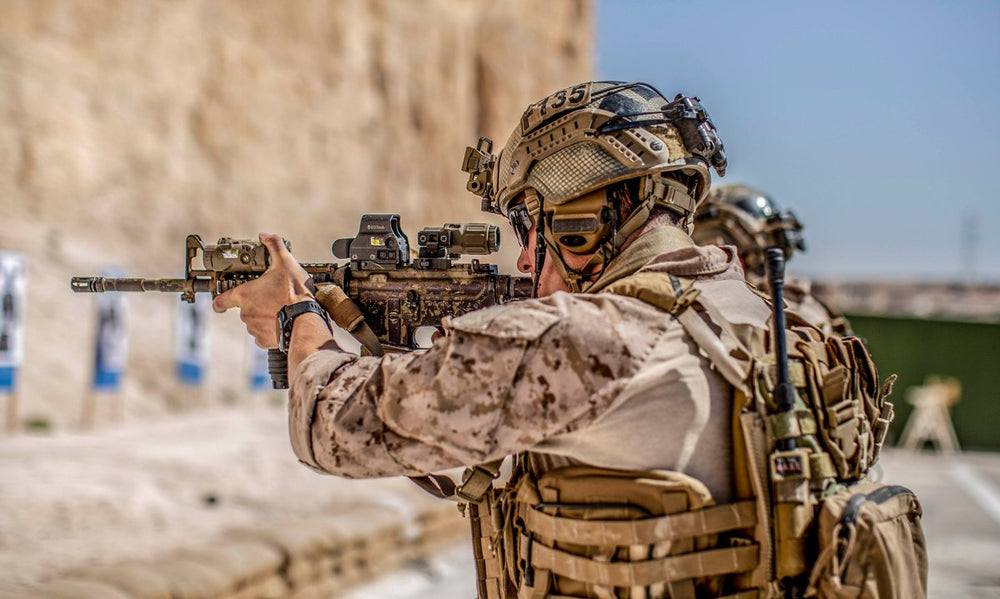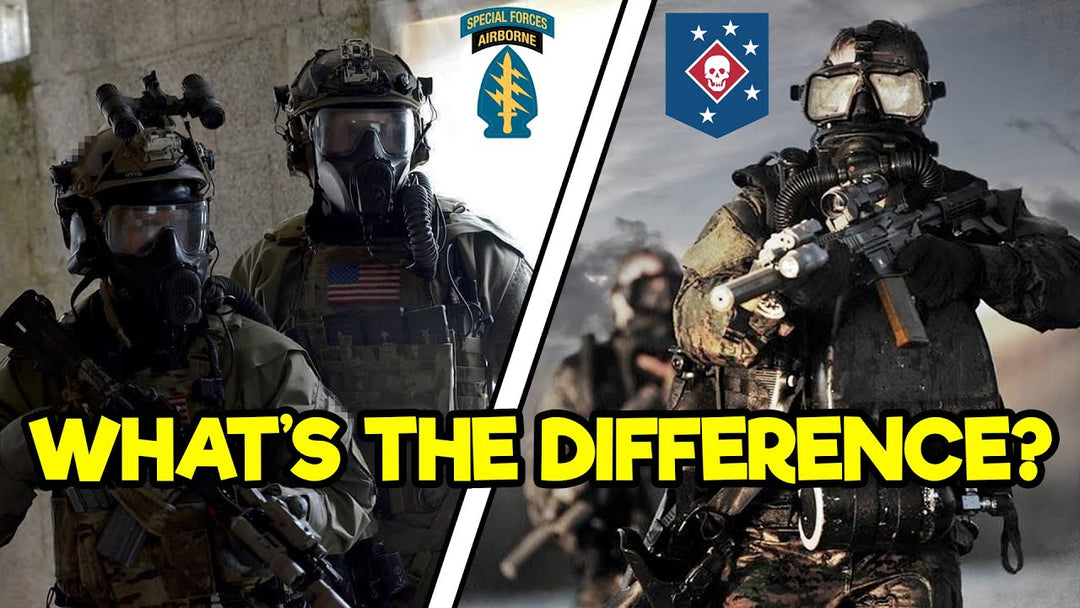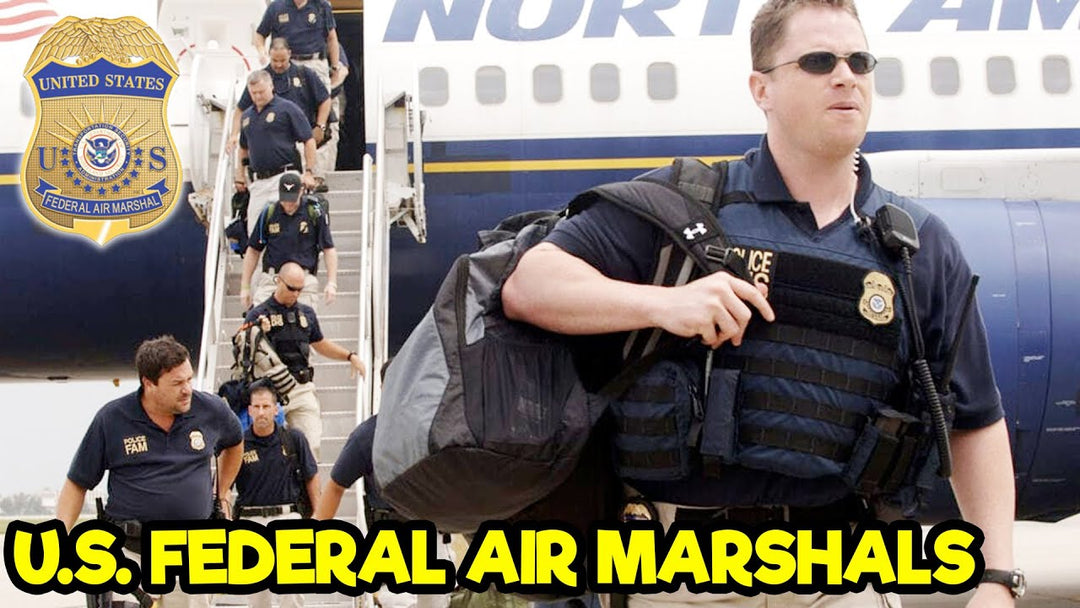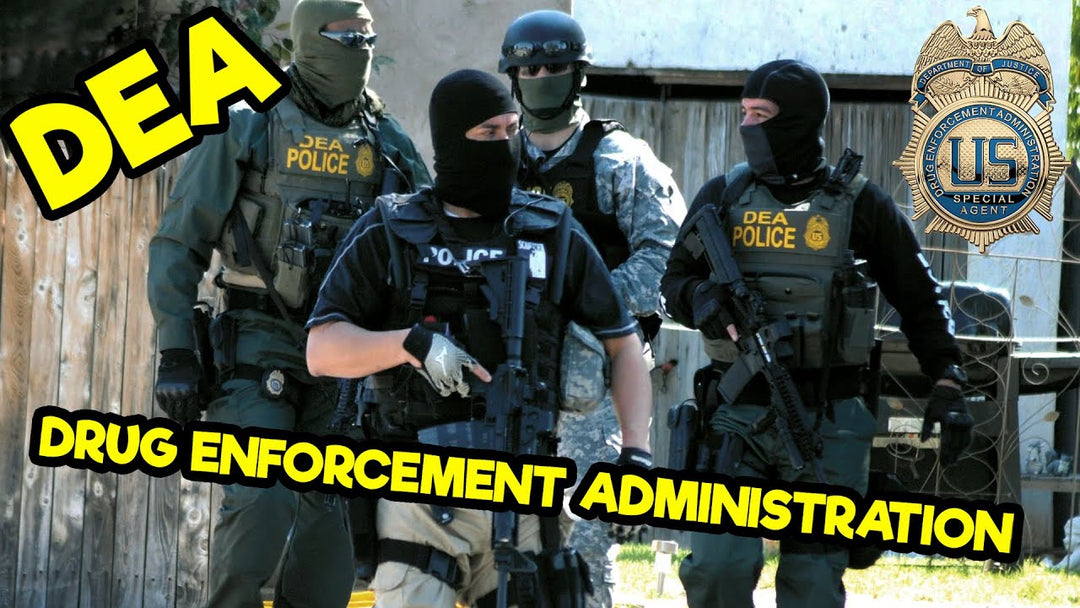Every U.S. Marine Corps Special Operations Unit Explained

It’s no secret that each branch of the U.S. military has something to bring to the table in the world of special operations. Each branch possesses highly capable units ready to take on extremely dangerous missions at a moment's notice, and that couldn’t be more true for the United States Marine Corps. Despite being the newest face at the SOCOM table, the creation of MARSOC in 2005 would be a game changer. Even though MARSOC is technically the only true special operations force in the Marine Corps, there are a wide variety of badass career fields and units that are adjacent to other special operations forces, and that’s exactly what we’re going to cover in this blog post.
But how exactly does the Marine Corps create badass units that stand out from the rest? What exactly are these elite units? What do they do? And what exactly is their purpose? Keep reading, and we’re going to answer all of those questions for you, and much more.
TABLE OF CONTENTS
U.S. MARINE SPECIAL OPERATIONS: MARINE RAIDERS (MARSOC)
U.S. MARINE SPECIAL OPERATIONS: MARINE RECONNAISSANCE
U.S. MARINE SPECIAL OPERATIONS: MARINE EXPLOSIVE ORDNANCE DISPOSAL (EOD)
U.S. MARINE SPECIAL OPERATIONS: AIR NAVAL GUNFIRE LIAISON COMPANY (ANGLICO)
U.S. MARINE SPECIAL OPERATIONS: MARINE SPECIAL REACTION TEAMS (SRT)
U.S. MARINE SPECIAL OPERATIONS: CONCLUSION
U.S. MARINE SPECIAL OPERATIONS: MARINE RAIDERS (MARSOC)

While it would be fun to tell you that MARSOC was created in 2005 because the Marine Corps needed an elite unit, capable of operating effectively in a variety of hazardous environments, that wouldn’t exactly be true. Marine Corps leadership at the time believed their participation in SOCOM wasn’t necessary, as the units under their command were highly capable. Regardless, there was no stopping the creation of MARSOC, and they would quickly become the face of special operations for the Marine Corps.
The Marine Corps pulled Recon Marines from some of the Recon Battalions and stood up what was known as Marine Special Operations Battalions at the time, and the rest is history. Today, MARSOC is known as one of the most capable and effective special operations forces the U.S. military has to offer. And for good reason, they have a wide range of capabilities.
Their main missions are typical of what a special operations force does, which are Direct Action, Special Reconnaissance, Counterterrorism, Foreign Internal Defense, Security Force Assistance, Counterinsurgency, Support to Combating Weapons of Mass Destruction, and Unconventional Warfare. However, their main bread and butter is Direct Action and Foreign Internal Defense, which makes their operations and purpose extremely similar to those of the U.S. Army Green Berets.
Marine Raiders are officially known as Critical Skills Operators (CSO) and Special Operations Officers (SOO). The main difference is that CSOs are enlisted, and SOOs are commissioned officers. They operate in 14-man Marine Special Operations Teams, which are called MSOT’s for short. These MSOTs can specialize in four areas, which are Mountain Teams, Dive Teams, Jump Teams, and Mobility Teams.
Joining the Marine Corps’ only special operations unit is no easy feat. Unlike other special operations career fields, the only way to get into MARSOC is to serve as a conventional Marine first for a time. After that, they go through a grueling selection process known as Assessment and Selection, or A&S, and then move onto a fast-paced, intricate course known as the Individual Training Course, or ITC for short. Upon completion of the pipeline, they earn their “Dagger” and report to a Marine Raider Battalion.
U.S. MARINE SPECIAL OPERATIONS: MARINE RECONNAISSANCE (MARINE RECON)

You might be thinking to yourself, wait, what? Marine Recon isn’t special operations? Surprisingly, it is not, and that goes for Force Recon as well! But Marine Recon is special operations capable, and that one word makes a whole hell of a difference! It might seem like semantics, but Recon has an entirely different structure and answers to a different chain of command because of it. They support the Marine Air-Ground Task Force, which is essentially the way the Marine Corps as a whole is operationally run.
But make no mistake, Recon Marines do pretty much everything special operations forces do. They shoot, jump, and dive, and they can find themselves in danger just as much as anyone else. But their entire purpose is to provide Reconnaissance, as their name suggests, to the Ground Combat Element of the MAGTF. You could say that they’re the eyes and ears of the Marine Corps!
But in order to conduct reconnaissance, they need to be good at infiltration and exfiltration, all without leaving a trace that they were ever there. Infil and exfil can be done by means of diving, patrolling, and jumping. They’re trained to create hide sites where they will not be detected by the enemy, and can pack up and move without anyone knowing they were ever there.
Since Recon supports the infantry, and has extra capabilities that the infantry does not, it can carry out various specialized missions. Those missions can range from initial terminal guidance for aircraft, battlespace shaping, surveying, and conducting limited scale raids and ambushes.
In order to become a Recon Marine, a Marine will have to go through the 5 week Reconnaissance Training and Assessment Program, 12 Week Basic Reconnaissance Course, 3 weeks of Jump School, 8 Weeks of Marine Combatant Diving Training, and 3 Weeks of SERE training.
U.S. MARINE SPECIAL OPERATIONS: MARINE EXPLOSIVE ORDNANCE DISPOSAL (EOD)

The Marine Corps is one of the many branches of the U.S. Military that has EOD technicians. EOD stands for Explosive Ordnance Disposal. EOD technicians are like bomb squads, they render safe bombs and various types of explosives. But each military branch's EOD comes with its own nuances, and the Marine Corps EOD is no exception.
Marine EOD supports the MAGTF, conventional Marine Units, and can even embed into MARSOC. What sets Marine EOD apart from the rest of EOD is that not only do they get to support Marine Corps units, but they’re also joining Navy EOD as the second EOD community to begin diving. That’s right, up until a few years ago, Navy EOD exclusively dealt with underwater explosives, but the Marine Corps is slowly dipping its feet in the water, pun intended, on that endeavor.
Like MARSOC, Marine EOD is not a guarantee for people who join the Marine Corps. Instead, they have to serve for a number of years before they can try out. Marines will be screened by an EOD unit to see if they’re worth giving a shot at training. The screening consists of a PFT, CFT, bomb suit agility test, and various interviews and assessments. If selected, the candidate will be approved for training and will be sent to an EOD unit to perform around 90 days of on the job training. Afterwards, they’ll be sent to the academically intense EOD school. Upon completion of EOD school, they’ll be sent to work as a tech in a Marine EOD unit.
U.S. MARINE SPECIAL OPERATIONS: AIR NAVAL GUNFIRE LIAISON COMPANY (ANGLICO)

Unlike the first three communities discussed in this blog post, ANGLICO is a unit, not a job. This means that a variety of MOS’s, predominantly 0861’s and 0261’s, have the opportunity to join this unit. But what exactly is ANGLICO?
ANGLICO stands for Air Naval Gunfire Liaison Company. This unit is unlike pretty much any other Marine Corps unit out there, because not only is their mission super unique, but they pretty much never operate with other Marine units. As a general rule, ANGLICO’s entire purpose is to support non-USMC forces, being divided into elements appropriate for each level of the other force's structure.
In a nutshell, ANGLICO provides support to other units to assist the MAGTF commander in coordinating their actions with the rest of the MAGTF on the battlefield. They provide small teams to combat elements who desire the ability to summon supporting fires from Artillery, Gunships, Bombers, or Naval Gunfire Support. Although ANGLICOs are best known for their ability to control Close Air Support, they are equally well trained to employ ground and sea-based fires, to include cannon artillery, rocket artillery, precision guided munitions, and naval gunfire support.
Because of the varying sizes of forces they work with, ANGLICO Marines are split into different operating elements. There are Division Cells, Platoons, Supporting Arms Liaison Teams, or SALTs, and Firepower Control Teams, also called “FCT’s”.
FCT’s are the basic unit of ANGLICO operations, which can consist of around 4 to 5 Marines, and two FCTs are in SALT. You gotta love military acronyms! Because of how small a FCT is, they participate in ground combat operations alongside their support unit, allowing for detailed integration into patrols, raids, and defensive operations.
Despite how different ANGLICO is from the rest of the Marine Corps, there is no formal selection process to get in. Oftentimes, Marines will get orders to join this unit similar to how they would get orders to join a conventional unit. The only formal training a Marine will get is from the ANGLICO Basic Course, which each ANGLICO independently runs and is not standardized between the companies. But despite that, being an ANGLICO Marine affords a wide variety of opportunities that many Marines would never be able to get in other conventional units.
U.S. MARINE SPECIAL OPERATIONS: MARINE SPECIAL REACTION TEAMS (SRT)

Special Reaction Teams are part of several different institutions in United States law enforcement, and the Marine Corps is no exception. The USMC Special Reaction Teams, or SRT for short, consist of military policemen attached to a Marine Corps Base Provost Marshals Office who are always on standby to respond to situations such as active shooters, hostage situations, and barricaded subjects. In other words, you can say they’re like the SWAT team for a Marine Corps Installation.
SRT works on an emergency basis. When a threat is deemed too high risk for a patrolman, SRT receives a call to neutralize the subject. Their main goal is to contain, control, and dominate a threat psychologically or physically. SRT members are trained on enhanced marksmanship, tactical movement, entry, breaching, and clearing objectives in order to neutralize threats.
An SRT consists of roughly 9 to 14 or more MP’s who have proven themselves capable of handling its intense mission set. An SRT will typically consist of a team leader, point man, two defensemen, rear security, two marksmen, and two observers. However, the team members cross-train to be able to adapt to any role in the team.
In order to join the SRT, a Marine has to be an MP with the MOS of 5811. They will have to volunteer at their command, where they will be evaluated through a strict screening process. While each installation will do things a little bit differently, they will all have to have good PFT and CFT scores, have an expert qualification score on the rifle and pistol, pass several interview boards, and prove that they would be a good member of the team. If selected, they will attend a two-week training curriculum to get them up to speed and get started with the SRT.
But the initial training is only the beginning for SRT members. SRT is constantly developing and training for the evolution of possible situations and scenarios. They stay ready to react to any scenario that falls within their mission set.
U.S. MARINE SPECIAL OPERATIONS: MARINE FLEET ANTI-TERRORISM SECURITY TEAM (FAST) AND RECAPTURE TACTICS TEAM (RTT)

Marine Corps FAST, which stands for Fleet Anti-Terrorism Security Team, are groups of Marine Security guards who are capable of rapidly deploying to immediately improve security at U.S. government installations worldwide. The Marine Corps is the only military service that is entrusted with the responsibility of providing security for U.S. Embassies and Consulates around the world, and FAST takes that to the next level.
They maintain forward-deployed platoons at the installations they are based in and are tasked with responding to unforeseen contingencies that can pop off at a moment’s notice. Additionally, one of their primary missions is to reinforce or recapture critical U.S. infrastructure in their specified area of operations. In order to be able to accomplish their mission, they conduct specialized training to include non-combatant evacuation operations, close quarters battle, urban terrain operations, convoy operations, shipboard operations, and specialized security operations.
The Recapture Tactics Teams, on the other hand, are also Marine Security Guards with extra training compared to their counterparts. In fact, the training they receive is pretty similar to what FAST marines get. The main difference between the two, however, is that Recapture Tactics Teams do not deploy. Instead, they remain stateside, and they protect the United States’ nuclear assets on Nuclear Weapons Stations. In other words, FAST Platoons deploy to areas in need of naval security operations, but Recapture Tactics Teams have no need to deploy because they are already positioned in the appropriate strategic locations where they are most needed.
In order to join FAST or Recapture Tactics Teams, Marines will not only have to become Marine Security Guards, but they will also have to complete the 35-day Close Quarters Battle course to earn the Close Quarters Battle Team Member MOS.
U.S. MARINE SPECIAL OPERATIONS: CONCLUSION

As you’ve just learned, the Marine Corps is home to a wide variety of communities and units that do things a cut above the rest of the branch. Despite having only one bona fide special operations unit, the Marine Corps as a whole does a great job of standing out amongst the rest of the U.S. Military Branches.
If you want to learn more about the military, law enforcement, or government entities, we have a YouTube channel dedicated to providing the best info out there, plus we have a growing list of blog posts as well. Click the links to take you to them!
General Discharge is a veteran-owned, veteran-operated organization that is dedicated to providing the best U.S. Military and Law Enforcement information. With over 250 YouTube videos, over 45 million views, and hundreds of thousands of followers, we have contributed to the success and knowledge of both the current and future generations of service members.






Leave a comment